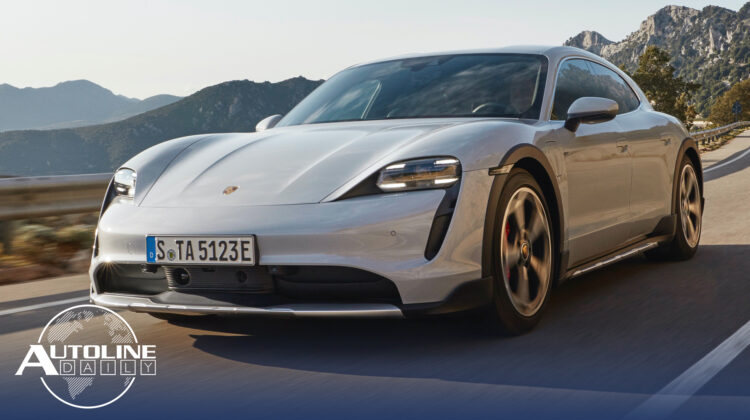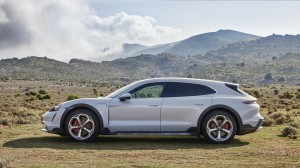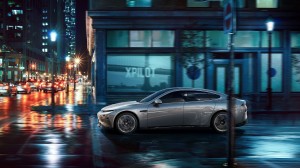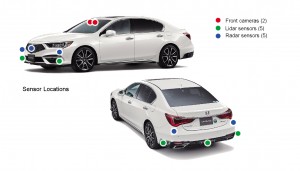
Listen to “AD #3030 – Porsche Taycan Cross Turismo; Study Says VW EV Platform on Par with Tesla; Honda Leasing L3 Vehicles in Japan” on Spreaker.
Follow us on social media:
Runtime: 11:42
0:08 U.S. Grid Needs to Get Greener
1:07 Ford Producing New Maverick Pickup in Small Numbers
1:53 Study Says VW EV Platform on Par with Tesla
2:38 Porsche Launches Taycan Cross Turismo
4:49 Xpeng Now Offering LFP Batteries in Vehicles
5:40 Honda Now Leasing L3 Vehicles in Japan
6:36 New Bronco Designed for Easy Customization
7:15 Volkswagen Accelerates EV Targets
9:25 Low Car Inventories Not Good for Captive Finance Companies
Visit our sponsors to thank them for their support of Autoline Daily: Bridgestone, Intrepid Control Systems and Magna.
This is Autoline Daily, the show dedicated to enthusiasts of the global automotive industry.
U.S. GRID NEEDS TO GET GREENER
Austin, Texas has a fleet of a dozen electric busses. But when that winter storm took down the Texas grid, those busses were useless. Not only does Texas need to guard its grid against extreme weather, it needs more generating capacity. But so does the whole United States. Reuters reports the U.S. needs to double its generating capacity by 2050 to accommodate EVs. The Boston Consulting Group says the average utility company needs to spend anywhere from $1,700 to $5,800 for every EV added to the grid by 2030, which would bring the total bill to $200 billion. But Reuters cites other utilities saying they can handle the transition and will not need more capacity until after 2030. One thing they all agree on: the grid needs to get greener or we won’t make progress fighting climate change.
FORD PRODUCING NEW MAVERICK PICKUP IN SMALL NUMBERS
Well, it’s official. Kinda. Ford hinted at production of a new small pickup truck called the Maverick. Ford’s latest production report shows that its plant in Hermosillo, Mexico made 21 of them last month. That’s where the Bronco Sport is made, too. Here’s what we know about the baby pickup. Base price: just under twenty grand. Four-cylinder, front wheel drive, with all wheel drive optional. Based on the same platform as the Bronco Sport, which itself is off the Escape. It’s not a work truck. It’s a lifestyle truck. Translation: it’s for carrying bikes, motorcycles, camping equipment and that sort of stuff. Look for it to hit showrooms by the end of the summer.
STUDY SAYS VW EV PLATFORM ON PAR WITH TESLA
Tesla has a big advantage in electric vehicles compared to traditional OEMs. But one automaker is catching up. UBS tore down the Volkswagen ID.3 and found that it “will be fully cost competitive with Tesla and boast best-in-class energy density and efficiency.” The analysts say it’s “the most credible EV effort by any legacy auto company so far.” The report estimates that the ID.3’s gross margin is around 15%, which is nearly on par with the Golf. Wall Street loved the news and pushed VW’s valuation over $100 billion, which hasn’t happened since its diesel scandal.
PORSCHE LAUNCHES TAYCAN CROSS TURISMO
Porsche unwrapped the Cross Turismo version of the Taycan. It will launch with 4 variants with power ranging from 280 kW up to 460 kW. But they’ll all come standard with a 93.4 kWh battery pack, all-wheel drive and adaptive air suspension. Standard ride height is 20mm or roughly ¾ of an inch higher than the sedan, but an optional Off-Road package allows for an additional 10mm of ground clearance. Porsche says WLTP range goes up to 456 kilometers, which is about 283 miles and very similar to the sedan. But remember the EPA rates it at around 200 miles. We would expect the Cross Turismo to be right around there as well. We’ll know soon enough. It launches in Europe this summer. By the way, if you want to convert kilowatts to horsepower, multiply the kilowatts by 1.34.
XPENG NOW OFFERING LFP BATTERIES IN VEHICLES
Chinese EV startup Xpeng, is now offering lithium iron phosphate or LFP batteries in its P7 and G3 models in addition to lithium nickel manganese cobalt or NMC batteries. In the P7, its range with LFP batteries is about 300 miles based on the NEDC test, compared to about 364 miles with NMC batteries. It carries a starting price of $35,500 including incentives. The G3 with LFP batteries has a range of 285 miles based on the NEDC, which starts just over $23,000. LFP batteries are not as efficient, but they’re a lot cheaper and less prone to catching fire.
HONDA NOW LEASING L3 VEHICLES IN JAPAN
Starting today, Honda is leasing its Legend Hybrid EX in Japan equipped with Level 3 autonomous technology. That’s the Acura RLX here in the States. The automaker did a good job of integrating sensors into body panels, to keep styling similar to regular models. The system only works on the freeway and will control all vehicle functions, even changing lanes on its own. And in certain low-speed situations it allows the driver to watch TV or a DVD on the navigation screen. However, if the driver doesn’t respond when the system tries to hand over control of the car, it will automatically bring it to a stop on the side of the road. While this gives Honda bragging rights for being the first automaker to sell a vehicle with Level 3 technology, it’s only going to lease 100 of them at a price of $102,000.
NEW BRONCO DESIGNED FOR EASY CUSTOMIZATION
We know Ford is going after Jeep with the all-new Bronco 2- and 4-door and one area it saw it could improve upon is the ease of customization. It was literally designed right into the vehicle. Yes, things like the doors and roof are easy to remove, but the fenders also come off with just a couple of bolts and the fender flares themselves are held on by quarter-turn fasteners. Not sure which part or piece might come off? Ford went as far as to stamp Bronco logos on body and interior bolts so you’ll know what’s removable. It says any person with any skill level can customize their vehicle.
VOLKSWAGEN ACCELERATES EV TARGETS
Volkswagen continues to aggressively ramp up its EV targets. It just doubled its forecast for electric vehicle sales. By 2030, it expects over 70% of its European mix to be fully electric and 50% of its Chinese and U.S. sales. But even with the bigger mix of EVs, Volkswagen is still targeting an operating profit margin of at least 6% by 2023. It plans to hit that by reducing fixed and material costs, but also by generating more revenue through its vehicles. It says it will start making its vehicles with virtually everything built in and customers will be able to pay to unlock what features they want. VW says this will significantly reduce production complexity and make access to individual mobility more affordable. In 2025, VW plans to launch an EV below the ID.3 that starts at 20,000 euros. But it also allows it to charge for charging and energy services, other software-based functions and even self-driving. It says it will launch its first Level 2+ system in 2026 and by 2030 “will make autonomous driving widely available.” Obviously, VW will still be making vehicles with combustion engines for a while and confirmed the Golf, Tiguan, Passat, Tayron and T-ROC will all see another all-new generation. They’ll be made more efficient by being offered in plug-in hybrid setups, which will provide an electric range of up to 100 kilometers or a little over 60 miles.
Coming up next, John shares insight into why low inventories are great for car dealers but a threat to automakers with a captive finance company.
LOW CAR INVENTORIES NOT GOOD FOR CAPTIVE FINANCE COMPANIES
Car dealers are making record profits, and a key reason why is they have fewer cars on their lots. That’s an opportunity for dealers, but it’s a threat to the car companies–or at least the ones with a captive finance company.
Let me explain. There are 1 million fewer vehicles sitting on dealer’s lots right now compared to a year ago. So they’re turning those cars over faster. And that is slashing their floor plan costs.
For example, Penske Automotive sold 400,000 fewer vehicles last year. It took in almost $3 billion less revenue. Yet profits shot up 25%. They were up 97% in the fourth quarter. A key reason why is it cut its floorplan costs almost in half.
Dealers buy cars from the factory and borrow the money to buy them. That’s the floorplan cost. The longer a car sits on the lot, the more interest they pay. But with cars selling faster, floorplan costs are plummeting. And that’s going to hurt the companies that lend the money—like the captive finance houses at the car companies.
But don’t worry, they’ll still be plenty profitable. The fincos, as these finance companies are called, are a great gig to have. Think about it. You lend dealers money so they can build their dealership. Then you lend them money so they can buy cars to put in their dealership. Then you lend money to their customers so they can buy those cars.
Tell you what. Sure wish I had me one of them fincos. I’d be laughing all the way to the bank.
But that’s it for today, thanks for watching and have a great weekend.
Thanks to our partner for embedding Autoline Daily on its website: WardsAuto.com

John McElroy is an influential thought leader in the automotive industry. He is a journalist, lecturer, commentator and entrepreneur. He created “Autoline Daily,” the first industry webcast of industry news and analysis.










